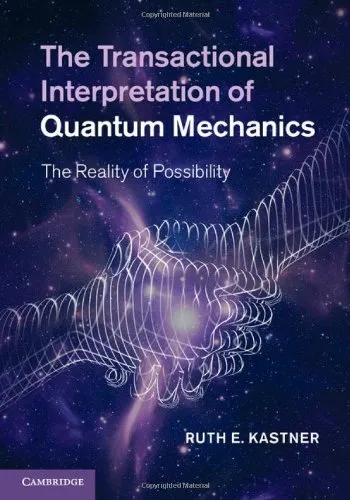The Transactional Interpretation of Quantum Mechanics: The Reality of Possibility
4.5
Reviews from our users

You Can Ask your questions from this book's AI after Login
Each download or ask from book AI costs 2 points. To earn more free points, please visit the Points Guide Page and complete some valuable actions.Introduction to "The Transactional Interpretation of Quantum Mechanics: The Reality of Possibility"
"The Transactional Interpretation of Quantum Mechanics: The Reality of Possibility" is a pioneering work that delves into one of the most groundbreaking interpretations of quantum mechanics, authored by Ruth E. Kastner. This book revitalizes and extends John G. Cramer's Transactional Interpretation (TI), offering a fresh perspective on quantum phenomena. Casting aside traditional assumptions about reality, the book posits an innovative framework to understand quantum processes, exploring the fertile middle ground where potentiality transitions into actuality.
In quantum mechanics, the paradoxical concept of nature's dual appearance—as particles and waves, as deterministic yet probabilistic—has puzzled scientists and philosophers for decades. This book meticulously illustrates how the Transactional Interpretation resolves contradictions within conventional quantum theory, framing quantum processes in terms of transactions—bidirectional exchanges of advanced and retarded waves. What separates this interpretation from others is its embrace of existence at the level of possibilities, opening up profound implications for the nature of reality and the role of observers within it.
Detailed Summary
The book systematically introduces the Transactional Interpretation (TI), beginning with the foundations of quantum theory. It revisits core quantum phenomena like wave-particle duality, entanglement, and nonlocality before addressing the uncomfortable aspects of the orthodox Copenhagen Interpretation and many-worlds theory. From there, the text considers the limitations of popular interpretations, arguing for a more holistic view.
Central to the book is the concept of "possibility waves" and their role in transactional interactions between an emitter and absorber. Rather than proposing a deterministic collapse of the wavefunction due to observation, the Transactional Interpretation sees the quantum collapse as a completed "transaction" that transfers energy, momentum, and other conserved quantities. While TI remains consistent with standard quantum mechanics' predictions, its underlying conceptual framework is significantly different, using physical reasoning to explain the "spooky" features of the quantum world.
Later chapters delve into the metaphysical consequences of this interpretation. The idea of possibilities existing in a "prephysical space" (termed as the "possibility space") radically extends the transactional framework, exploring how actuality crystallizes from potentiality. The book also discusses time symmetry and retrocausality, addressing how advanced waves traveling backward in time play a central role in TI. This rethinking of temporal directionality provides an elegant solution to long-standing puzzles in quantum mechanics, such as the measurement problem and the nonlocal correlations between entangled particles.
Key Takeaways
- Transactional Interpretation as a framework: TI offers a compelling interpretation of quantum phenomena that resolves paradoxes without invoking observers or parallel universes.
- Reconceiving reality: Reality, as understood in the light of TI, transcends deterministic event sequences and incorporates the potentiality space as a precursor to actualized events.
- Time and causality: The book's exploration of retrocausality provides a new way to understand time symmetry and the flow of causation in quantum mechanics.
- Beyond measurement: TI explains quantum measurement without the controversial "observer effect," pointing instead to transactional exchanges between emitters and absorbers.
- Philosophical significance: By addressing foundational questions about existence, possibility, and actuality, the book bridges the gap between physics and metaphysics.
Famous Quotes from the Book
"The measurable world of quantum mechanics is but a projection of deeper processes, where the fabric of reality is woven from transactions of possibility and actuality."
"Quantum mechanics isn't just a probabilistic tool—it is a profound statement about the nature of existence, grounded in the interplay between what could be and what is."
"Reality does not collapse into being because we observe it; it completes itself through a mutual handshake of advanced and retarded waves."
Why This Book Matters
Ruth E. Kastner’s book is a crucial contribution to the ongoing conversation surrounding the interpretation of quantum mechanics. It not only revitalizes the largely overlooked Transactional Interpretation but also extends it beyond its original formulation to provide a richer, more robust understanding of quantum phenomena. By situating the discussion within the realm of what is possible rather than strictly actual, Kastner pushes the boundaries of modern physics, inviting readers to envision a universe where possibility plays a fundamental role in shaping reality.
This book is essential for physicists, philosophers, and anyone intrigued by the mysteries of quantum theory. It challenges traditional approaches to understanding reality, offering a promising route to reconcile quantum mechanics with broader metaphysical questions. The Transactional Interpretation holds the potential to unify disparate perspectives, situating quantum mechanics in a conceptual framework that resonates with both scientific intuition and philosophical inquiry.
Free Direct Download
Get Free Access to Download this and other Thousands of Books (Join Now)
For read this book you need PDF Reader Software like Foxit Reader


